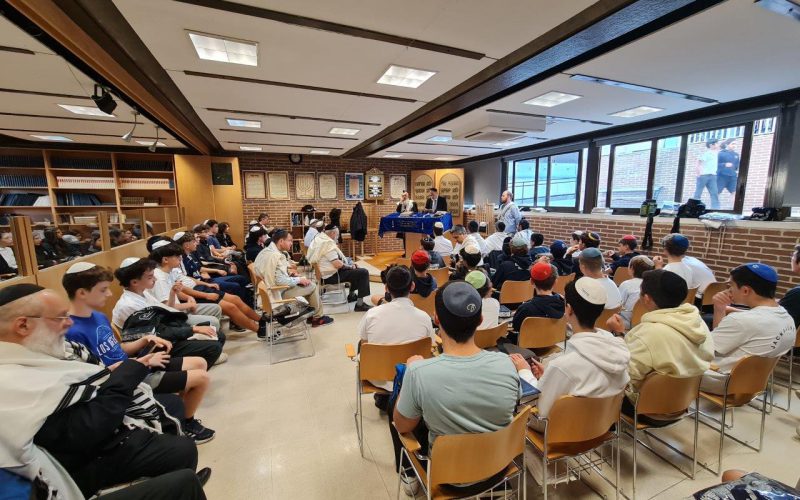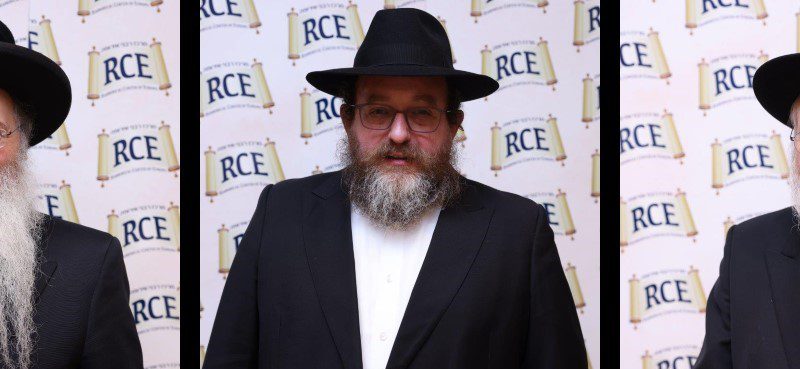The “Kollelei Torah” Revolution

Winds of change are blowing in the CIS, and it’s not a political or military revolution, but a genuine revolution of Torah learning, unprecedented by any measuring rod. Every day 2,500 men spend several hours studying Torah as a daily regimen in over 100 cities in the CIS and Europe. Another 1,500 women learn about Yiddishkeit in 65 cities in the CIS and Europe. This is happening here and now, in twenty-first-century Russia, in European communities that everyone had already mourned and eulogized, in Euro-Asia, which everyone thought was experiencing a spiritual death, becoming a continent without a Jewish/Torah future.
The studies follow an organized, high-quality, consistent curriculum, which was put together by a group of talmidei chachamim and shluchim who have a great deal of experience in the field. Heading this group is Harav Akiva Nimoy, one of the shluchim to Berditchev, an esteemed talmid chacham. Together with a team of selected translators, Harav Nimoy is in charge of publishing the booklets that are used. The program received the blessing of Chief Rabbi of Russia Harav Berel Lazar, who is Chairman of Russia’s Shluchim Committee.
Each participant receives a beautifully laid-out study booklet in two languages, Russian and Hebrew, and then joins a large group of fellow talmidim. The study materials are divided into five topics: Gemara, Mishnah, Halachah, Chassidus, and Parshas Hashavua. And the students benefit from a generous stipend for learning. A steering committee of shluchim tracks the students’ levels and their progress. At the end of each month the talmidim are tested on what they have learned, and a special bonus is awarded to those who excel, over and above the standard monthly grant.
In the summer months, as end-of-year activities, special seminars are held in tourist sites in various European cities, bringing together all the outstanding students, along with the Rashei Kollel. These seminars feature, in addition to regular classes, lectures by well-known speakers, as well as farbrengens and tours. The climax is the joint trip to Israel at the end of the year, which is also part of the end-of-year activities.
Thanks to this program, residents of over 100 cities in the former Soviet Union and the rest of Europe are no longer ignorant of their Yiddishkeit. They are proud Jews who understand what it means to be Jewish, toiling in Torah as their great-grandparents did a century ago and more, in Europe before the Enlightenment and secularism movements, and in Russia before the times of the persecution of Soviet Jewry; as it had been in the years before Jewish symbols disappeared from public view; as it had been in Europe before the times of intermarriage and intellectual assimilation. In all those places, Torah and Yiddishkeit is coming back to life, waking up thousands of lost souls along with it.
This is not merely people watching a public Chanukah candle-lighting, taking part in a communal Pesach Seder, or listening to the Megillah with a grager in hand. This is genuine Torah learning – the fundamental aspect of Yiddishkeit. It is the highest aspiration of any shaliach who seeks to fulfill the mission with which the Lubavitcher Rebbe entrusted him when he sent him to a place that had no Jewish infrastructure, and instructed him to gather souls, to kindle a spark within them, and to bring Jews back home. And they are coming home! They are returning in droves to the same wonderful beis medrash, to the same Gemara, to the Shulchan Aruch, to the teachings of Chassidus.
The Result: Tens of Thousands
As we know, Torah changes a person, purifies him and elevates him to lofty heights, turns him into someone who is deeply connected to the One Who gave the Torah, uniting him with the Essence of the Creator. This is exactly what is happening to tens of thousands of Jews, family members of the thousands of students of “Kollelei Torah” and the women and girls who are learning about Yiddishkeit in 65 cities. This is the strongest, most revolutionary initiative put into practice since the Rebbe sent his holy shlichim to those countries. These thousands of family members are directly influenced by the father, son, brother or sister whose soul yearns for Hashem’s Torah. Dozens of women have influenced their husbands to begin to observe mitzvos.
The program’s curriculum was developed by the Rohr Jewish Learning Institute (JLI), headed by Rabbi Ephraim Mintz and Rabbi Dubi Rabinowitz. The women shlichos have upgraded the women’s classes dramatically.
Mohalim across the Soviet Union are reporting a 200 percent increase in the demand for brisos. Tefillin dealers have received thousands of requests for tefillin needed by people who have begun to fulfill this mitzvah and connect with the Creator. It is no longer the shaliach who sets up tefillin campaigns; it is the one family member who makes a “campaign” for all his relatives, who join him in observing mitzvos. One friend brings another, one brother brings another, fathers’ hearts influence their sons’, and sons’ hearts influence their fathers’. And the phenomenon is spreading and embracing families – families that are returning to their roots through the powerful spiritual initiative of “Kollelei Torah.”
We are speaking of men and women who, until the Kollelei Torah network was established throughout Europe two years ago, had never set foot in a shul and were unfamiliar with even the most basic concepts of Yiddishkeit. They didn’t know the difference between a sefer Torah and a phone book, between tefillin straps and a leather belt. They were victims of hundreds of years of detachment, alienation, and ignorance of their heritage. They were smoldering embers, whose Godly Jewish souls were the only link that still connected them to Judaism.
Today, two years after the Kollelei Torah revolution began, they are able to understand the writings of Chassidus. They know who Abaye was and why he disagreed with Rava; they know the meaning of complex Talmudic concepts; they are taking their first steps into the world of Kabbalah. These thousands of Jews, most of whom had no idea about basic Jewish concepts, already know how to guide their families in hilchos Shabbos, birchos hanehenin, family purity, and other areas of halachah found in the Shulchan Aruch.
Entering one of the kollelim of the Kollelei Torah network is one of the most emotionally moving experiences imaginable. Row upon row of people sit and study, some in groups listening to shiurim, others paired as chavrusos, learning new material and reviewing it, learning pilpul and in depth, gaining fluency and being tested. They no longer come to ask the Rav every question they have, for they themselves are already connecting to the Source from which the Rav draws his own knowledge.
And the fruits do not stop sprouting: Entire families have made a complete turnaround. Children have brought their parents, and parents have brought their children. This phenomenon encompasses dozens of cities and communities. Shuls that stood empty and unused for years, where there have been no minyanim – turned into Torah centers full of life and enthusiasm. Jewish communities where the blackened coals of Judaism just barely bore a spark have become model communities centered around a core of Torah, based on local community members – Russian residents for generations – who have now become true bnei Torah, inculcating Torah into their souls and transforming their lives completely.
Kollelei Torah’s publishing department has already published Torah sefarim, authored by the laymen who learn in Kollelei Torah. And through this intensive learning program, an additional series of sefarim has been published. Talmidei chachamim who have examined them have expressed their admiration for their high quality.
“The participants are thrilled with the privilege they have been given to be part of this tremendous initiative, which will change the character of their communities,” said Harav Moshe Weber, who heads the Kollelei Torah project. Rav Weber is a veteran Chabad shaliach in Dnipropetrovsk, Ukraine, who has much experience in projects such as this one. He is confident that “with the [Meromim] Foundation, and in cooperation with the Rabbanim, this is just the beginning of a revolution that will gain momentum and that will give tens of thousands of Jews the opportunity to learn Torah and to glorify it.”
A Thirst for Torah Learning
A bit of history: This all began in Cheshvan, 5775/2014. At that time, the shluchim in the CIS and Europe heard about a revolutionary initiative to bring Torah learning to the members of their communities. This was the launching of the network of Kollelei Torah for daily Torah learning. The first twenty-five pioneer talmidim received a monthly stipend; and over the course of the next three years, some 100 more such kollelim were established. May there be many more.
The entire project is directed and sponsored by the Meromim Foundation (Keren Meromim), which has taken responsibility for funding the stipends for the Kollelei Torah talmidim, and it has the blessing of the Shluchim Committee of the CIS, headed by Russia’s Chief Rabbi Harav Berel Lazar.
The shaliach Harav Ben-Zion Lipsker of the “Maor” Chabad Center in St. Petersburg and of the Meromim Foundation (which backs this wonderful initiative and is the principal sponsor in funding the project and the participants’ stipends) explains the background of the project:
“As a shaliach and community rabbi, I saw firsthand the great thirst for Torah study that exists. This is certainly not to downplay the value of all the other programs and activities that have been used until now. But this is something altogether different; it is true Torah study, in which a Jew becomes seriously involved in learning Gemara, Mishnah, and the halachos of the Shulchan Aruch, in-depth study of Chassidus, and talmidim analyzing what they have learned in the manner of bnei Torah throughout history. This is truly a step up in the level of Torah learning. And it is all being done consistently, every day, requiring a strong, vital commitment to Torah study on the part of the participants. This program breathes new life into dozens of communities and shuls.”


